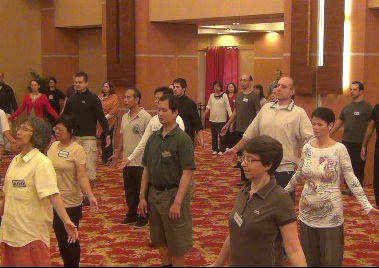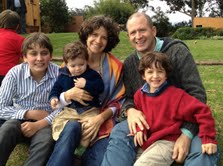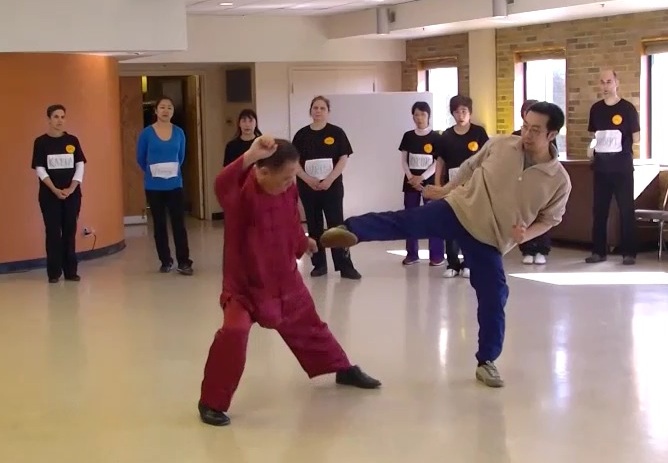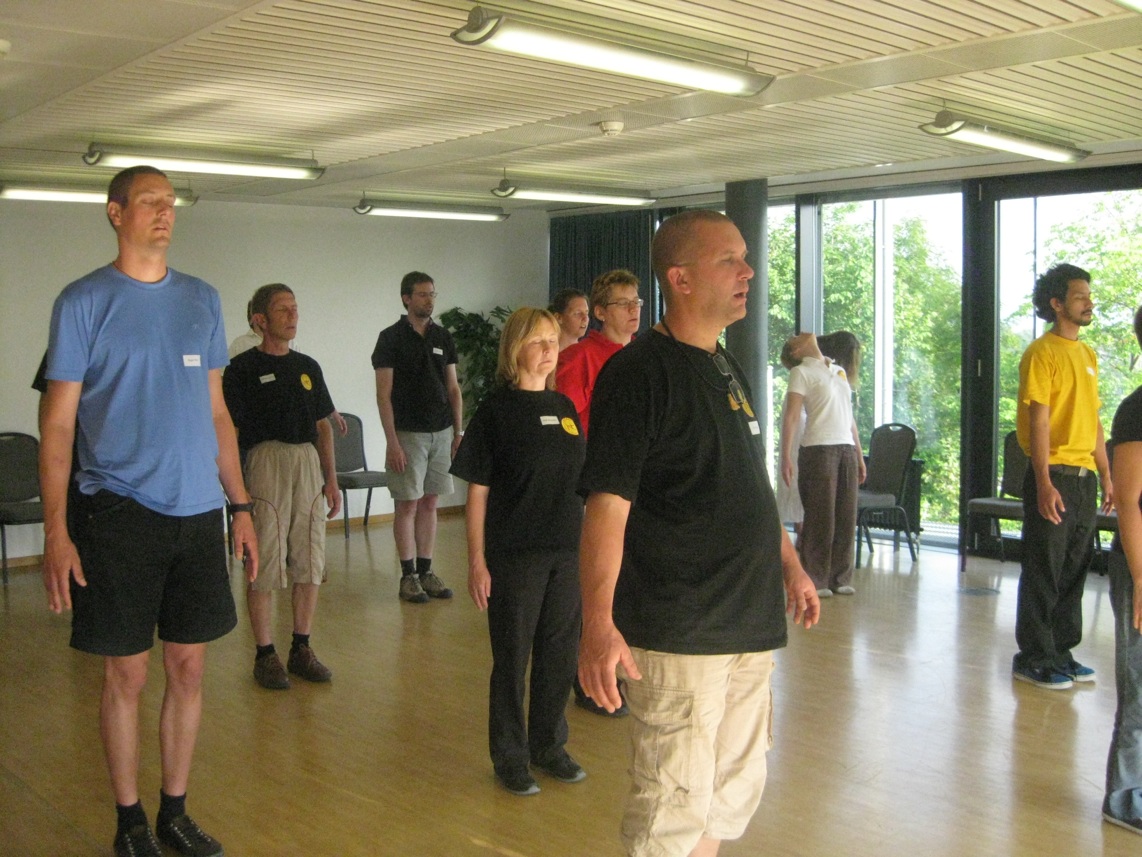SELECTION OF QUESTIONS AND ANSWERS
JANUARY 2015 PART 2

The Small and Big Universe Course in Penang
Question 1
I would like to thank Sigung again for being so generous in transmitting the skills of Small Universe to us during the Toronto course. It was an incredibly rewarding and powerful experience.
My first question pertains to Abdominal Breathing and Cosmic Breathing. As I progress with Abdominal breathing, sometimes I unintentionally switch to Cosmic Breathing.
For training and progressing in Small Universe, is this okay? I would sometimes have to gently re-visualize the Ren Meridian when I switch to Cosmic Breathing by accident.
— Stephen, USA
Answer
The Small Universe, as I mentioned at the course, not only gives you good health and vitality, and enables you to live beyond a hundred years, it will also make you lucky in both your private and public life. The Small Universeal chi flow brings good circulation of chi or "hou yun chi", which means good luck in Chinese.
Cosmic Breathing, the way we practice it like at the course, is even more advanced than the Small Universe. It leads to the Big Universe, enabling you to have a spiritual awakening.
It is perfectly fine if your spontaneous breathing switch between the Small Universe and Cosmic Breathing. But as a learning process, while you are still new in the skills, it would be recommended that you keep at the Small Universe when you wish to practice the Small Universe, and keep to Cosmic Breathing when you wish to practice Cosmic Breathing. But if the switch occurs spontaneously, just enjoy yourself.
Question 2
My second question pertains to the Ren and Du Meridians. When I let the Small Universe flow on its own, the chi doesn't seem to flow straight up my back and down my body. It seems to curve. I think this might have to do with having scoliosis when I was younger. Should I gently visualize to force the Small universal flow to be straight?
Answer
The Small Universe flows up straight along your du meridian at your back. But if there is some problem to be overcome, it may take a turn here and there. The curve flow is probably due to the scoliosis when you were younger. The Small Universe wonderfully overcomes all your problems, including those that you may have forgotten, even without you doing anything special.
You may sometimes visualize the flow to be straight, but don't force it. Generally let the flow be natural, but sometimes you may gently guide it. First practice "you-wei", i.e. generate the Small Universe. Then enjoy "wu-wei", i.e. let it flow spontaneously. Once a while, you may gently introduce "you-wei", then enjoy "wu-wei" again. Besides being very beneficial, it is also full of fun.

The aim of our chi kung training is to have a happy, healthy life here and now
Question 3
If we say, "Let go of all the emotions", do we also let go of positive emotions? Often people ask, that they understand to let go of the negative emotions; is it necessary also to let go of the positive ones, that are there at that moment?
— Adrian, Germany
Answer
At the highest level, let go of emotions means let go of all emotions, including positive emotions.
The aim of the highest is to attain Zen, called by different names according to different religion or culture as Buddhahood, returning to God the Holy Spirit, and merging with the Great Void. If a being has any emotion, including good one, he (or she) will be abided in the phenomenal realm, but not necessarily in our world. Bodhisattvas, for example, remain in the phenomenal realm, including in our world, because of their great compassion.
But we are not ready to attain Zen; we want to enjoy ourselves, wholesomely, in this world as long as possible. So for us, it is alright to have good emotions but we must not cling onto them. Just be aware of and experience the good emotions while in a chi kung state of mind. If one clings onto the emotions, irrespective of whether they are positive or negative, he would come out of the chi kung state of mind.
Question 4
Someone without a spleen asked me if a chi kung exercise for the spleen is especially helpful, when one does not have the organ anymore?
Answer
He should practice the exercise according to the way it is taught, irrespective of whether the practitioner has or has not a spleen or any organ, unless he is specifically told to do otherwise by a competent teacher.
Even when a physical spleen is not there, his energy spleen is present. Some of my students, for example, could still have sex after learning some special exercises from me even when their testicles had been removed, due to accident and not because they wanted to be eunuchs.

Ours is a chi kung and kungfu school, not a spiritual training centre
Question 5
Can we meditate at the end of a chi kung session any time period we want? I have an increasing number of people telling me that standing meditation is so nice, so that they like to stay in it for a longer time, for example 30 minutes or so. Chi kung training should only be 15 minutes, I know that, but what about the meditation itself?
Answer
When students practice chi kung, they should practice it the way it is taught by a competent teacher, not in a way they themselves think is better, in which case even without realizing it they attempt to be smarter than their teacher. In our school the structure of an exercise we teach is as follows.
- Introduction -- about 10% of the total practice time.
- Body -- about 80%.
- Conclusion -- about 10%.
The body of the exercise may be subdivided into two sections. For convenience we may call them "body-technique" and "body-benefit".
The proportion of time between body-technique and body-benefit varies according to some factors, like the attainment level of a practitioner and his objectives. If we take the time allotted for the "body" to be 100% (which is about 80% of the total practice time), for a beginner generating an energy flow the recommended proportion is 60-40, whereas for a master it may be 10-90.
Leaving aside quality of benefit for the time being, this difference of technique-benefit proportion explains why a master has more benefit quantitatively than a beginner when they spend the same amount of time in practice. If they spend 10 minutes for the "body" of practicing "Lifting the Sky", for example, a student spends 6 minutes to perform the technique, and enjoy 4 minutes of benefit in energy flow, whereas a master spends 1 minute to practice the technique and enjoy 9 minutes of benefit, if all other things were equal.
All other things are not equal. If the master is 4 times more efficient than the student, his benefit is 36 units of benefit whereas that of the student is 4 units, if both practice for 10 minutes. This also means that even when the master spends less time in his practice, say 5 minutes in which case he will have 18 units of benefit, he still has more benefit than the student who spend more time, like 4 units in 10 minutes of practice.
Returning to our structure of practice, when students practice exercises from the Eighteen Lohan Hands to generate an energy flow, for example, they should spend about 1 or 2 minutes to stand upright and be relaxed, smile from the heart and be in tune with the Cosmos. Then they should spend about 6 to 8 minutes to perform 1 or more exercises. This is followed by about 5 minutes of energy flow. Then they should spend about 1 or 2 minutes to complete the training session by thinking of their dan tian just once or twice, remaining still for a short while, and performing facial massage, point massage and heavenly drum before walking about briskly.
Once a while when conditions are suitable, they may have variation of this structure. They may, for example, remain in standing meditation in 5 or 10 minutes instead of 1 or 2. This is an exception, not the rule, and it issues from spontaneity, not on purpose.
If your students remain in standing meditation for 30 minutes as a rule and not as an exception, they are not practicing chi kung the way we teach it. They are changing our chi kung into a meditation exercise which we do not teach at their level. They are also trying to be smarter than me, who originated this method in our school that has brought a lot of benefits to thousands of people.
Your students do not mean to be disrespectful but are not likely to know the following fact. Changing the way an art was taught, like remaining in standing meditation for 30 minutes instead of 1 minute, was one of the main reasons why a wonderful art has been debased to gentle physical exercise.
These students may have some initial benefit, if not just pleasure, but they may have serious deviation later on. They are still new in the art of chi kung, and are very fortunate to learn our Shaolin Wahnam arts from you. Even if they can get just 30% of the potential benefit the art they now practice can give, it will be sufficient to enrich their daily life. On the other hand, don't attempt an advanced art, like meditation, straight away.
As an instructor, irrespective of whether you are new or experienced, you have to be firm with your students. If your students do not follow your instructions, ask them to leave. You have to he harsh to be kind.
Question 6
I understand that we are not a spiritual school, but as I grow deeper in chi kung, spiritual questions arise. How important are awakening and enlightenment for you and how important do you think this is in chi kung training, especially at your level?
Answer
It is important to remind ourselves that ours is a chi kung and kungfu school teaching people to enrich their daily life, not a school to teach people attain Enlightenment.
Spiritual cultivation, including answering spiritual questions, is an integral part of our chi kung and kungfu training. Genuine chi kung and genuine kungfu training is triple cultivation, i.e. cultivation of jing, qi and shen, which means cultivating the physical body, energy and spirit. We do not merely answer spiritual questions, as many people do, regardless of whether their answers are correct or otherwise, deep or superficial. We walk our talk, we enjoy spiritual benefits in a practical way.
But our spiritual benefits, for which we cultivate everyday in our chi kung and kungfu training, are not geared towards Enlighenment, though many of us are awakened, but are practical, everyday benefits like being relaxed, happy and free. We also have mental clarity and mental freshness, and are kind and compassion, and can readily forgive those who have wronged us.
For me in particular and for thousands of our Shaolin Wahnam Family members who train our chi kung at any level and follow my philosophy and practice, awakening and Enlightenment are important ultimately, but are not important immediately. In other words, we do not specifically train to attain Enlightenment, not even in our Zen courses. Except in advanced courses like Cosmic Breathing, Merging with the Cosmos, and the Small and Big Universe, we do not even specifically train to attain awakening. But at all levels, we purposefully train to be physically fit and healthy, energetically full of vitality, and spiritually happy and free.
Editorial Note: Adrian"s other questions will be continued at January 2015 Part 3 issue of the Question-Answer Series.

Meditation is an integral part of our chi kung and kungfu training
Question 7
How do we make sure to have good karma?
— Herman, Switzerland
Answer
You can make sure to have good karma by avoiding evil and doing good. Practicing the Ten Shaolin Laws is an excellent way to avoid evil and do good.
Question 8
What do you mean by good and bad? I think something is good but it may turn out to be bad. What is the karmic effect?
If I do something it is good for me, but it may be bad for my friend. What should I do?
Answer
Whatever that brings benefit is good; whatever that brings harm is evil.
Karma, or cause and effect, is caused by thought, words and deeds in this order of importance. As thought causes more karma than deeds, if you think something is good but it turns out to be bad, the karmic effect is still good.
Even when doing something is good for you but may be bad for someone else, don't do it. We do not build our benefit on others' suffering.
LINKS
Selected Reading
- The Chameleon
- A Landmark Moment of Spiritual Bliss
- Combat Sequences of Tiger-Crane Set
- Fun with Drunken Eight Immortals
- From Rocky Desert to Snowy Mountain
